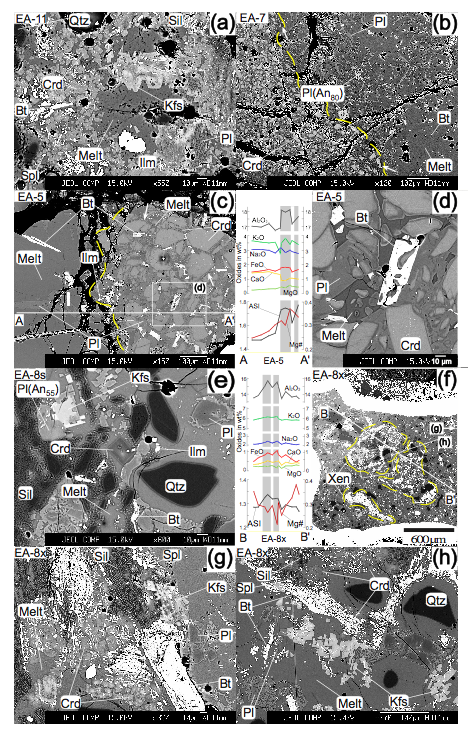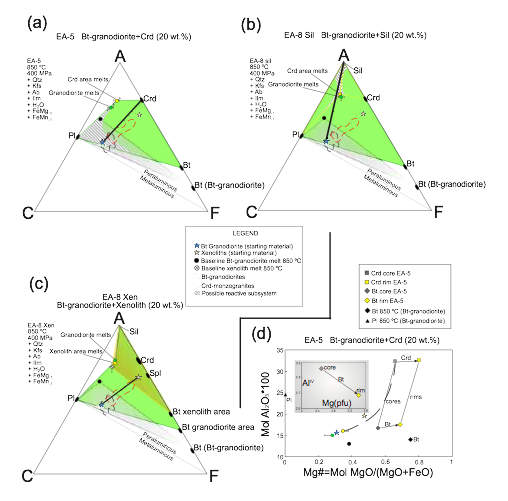The Gredos batholith, Central System, Spain



(a) Geological map of the Spanish Central System batholith. (b) Detailed geological map of the Barbellido-Las Pozas area (Sierra de Gredos, Central System batholith). Location in Fig. 1a. (c) WNW-ESE-trending geological cross-section showing the main structural features of the mapped area.

(a) Structural sketch of the area mapped in Fig. 4a. (b) Equal area, lower hemisphere projections of poles to the magmatic foliation and host-rock foliations in the mapped area. (c) and (d) Isocontour maps representing volume fractions of cordierite and K feldspar, respectively, in the granitoids of the mapped area.

(a) General view of Las Pozas Crd monzogranites outcrop (see Fig. 1b), including a large body of migmatitic hornfelses. (b) Magmatic foliation in the Crd monzogranites defined by the preferred orientation of Kfs megacrysts. (c) Intrusive contact between the Las Pozas Crd monzogranite and a body of hornfelses with small fragments (xenoliths) partially or totally enclosed by the monzogranite. (d) Magma-magma lobulate contact between the Barbellido granodiorite (right) and the Refugio del Rey leucogranite (left). (e) Euhedral, rectangular shaped crystals of Crd in Las Pozas Crd monzogranite. (f) Network of leucocratic veins pervading the migmatitic hornfelses.

U-Pb Concordia diagrams and relative probability histograms for the three studied samples. Data-point error ellipses in Concordia diagrams are 68.3% conf., including error from standard, and include the 2σ error bars diagram for ages between 280 and 350 Ma. Grey colored rhombs are coherent groups of ages used to obtain mean Concordia age. (a) U-Pb Concordia diagram for Bt granodiorite (sample J707-16). (b) and (c) are Concordia diagrams for the analyzed samples of Crd monzogranite (sample J806-3) and xenolith (sample J707-7), respectively. An enlarged area plot for Variscan ages is also shown. (d) Relative probability histogram for 206Pb/238U ages (listed in Table 3). Grey areas mark main ages of the host sediments to the Central System batholith

BSE images of experimental runs simulating the interaction between Bt granodiorite and potential mineral and rock contaminants. All experiments were carried out at 850 °C and 400 MPa. (a) Pelitic xenolith end-member. (b), (c) and (d) show the textures of runs with addition of Crd to the Bt granodiorite. (e) Texture and mineral assemblage of the run with addition of a Sil-rich spot to the Bt granodiorite. (f), (g) and (h) show the relations and minerals of the experiment with addition of a fragment of pelitic xenolith to the granodiorite. Compositional profiles of melts across the capsules are shown in (d) and (f).

ACF projected diagrams (A=Al2O3; C=CaO; F=FeO) plotting the coexisting assemblages and melts of composite experimental runs with addition of Crd (a), Sil-rich spot (b), and xenolith (c) to the Bt granodiorite. Molar proportions of ACF are projected by algebraic inversion of the compositional space defined by the components A, C, F, Qtz, Kfs, Ab, Ilm, H2O and the exchange vectors FeMg-1 and FeMn-1. The area of reactive subsystems has been traced tentatively according to qualitative observations of textures in the runs. The thick line with tick marks is the bulk mixing line of the two systems represented by the Bt granodiorite and the contaminant. Tick marks represent 10 wt% proportions of one of the two end-members. The composition of Crd monzogranites is close to the mixing array using xenoliths as contaminants (c). (d) represents the constant slope of the Mg# partitioning between Crd and Bt supporting the shift in composition of the local system with time. Note that new-formed Bt, both in the granodiorite layer and the Crd-rich layer, is richer in Al with respect to the baseline represented by the Bt composition in the granodiorite alone. The four phase assemblage depicted in (a) and (c) indicates the peritectic reaction that that forms Crd at expense of Bt. The remaining melt in the granodiorite system alone at the same PT conditions (red circle) is very close in aluminosity to the melts formed in the composite capsules (green circles). These relations point to a potential equilibrium of Crd in the residual melt of a partially crystallized granodiorite.
Projection of granitoids of the Gredos massif onto the pseudoternary projection defined by Opx-Or-An. Lines of multisaturation (cotectic like) are traced from experimental data with calc-alkaline systems. These represent liquid trajectories by either crystal fractionation or partial melting. Arrows mark the direction of decreasing T. Bt granodiorites of Gredos (grey circles) fairly follow the cotectic trend corresponding to liquids produced either by fractionation of an andesitic parental magma or by partial melting of a diorite solid source. Crd monzogranites follow a trend transversal to the general attitude of cotectic lines. The main transversal trend points to the composition of country rock pelitic xenoliths. These relations report that Crd monzogranites are resulting by bulk assimilation of pelitic metasediments by Bt granodiorite magma. Cotectic lines (1) and (3) correspond to experiments.

Evolution model of the Spanish Central batholith in the frame of the last stages of ductile Variscan deformation of the Central Iberian Zone. (a) Schematic cross section of the central part of the Spanish Central System during the activity of the extensional detachments characteristic of the Variscan second deformation phase (D2). Low-grade metamorphic rocks (green) were tectonically juxtaposed to high-grade domains (yellow), which became partially molten to generate a mid-crustal migmatitic belt. The rectangle indicates the approximate location of the area enlarged in (b) to (e). (b) Starting of the Variscan deformation phase D3, characterized by the activity of transcurrent (transtensional and transpressional) structures and large scale folding of the crust. Early basic magmas were intruded into the upper-middle crust. (c) Soon after the previous stage, several sheets of granitoid were emplaced along or near a former D2 extensional detachment, which represented a band of strong mechanical weakness mainly due to the presence of migmatites at the footwall of that tectonic accident. Ascent of mafic magmas accompanied the predominant granitoid magmatism. Granitoids emplaced into or at the contact with the low-grade metasediments and/or ferrosilicic migmatites experienced the assimilation process described in this work. (d) Ductile shear zones probably related to the D3 phase affected the previous granitoid sheets (e.g., the shear zone at the top of Las Pozas Cord monzogranite) and gave place locally to repetition of thin crustal units. Some granitoids still intruded during this stage. (e) Finally, the last deformation associated with the D3 phase generated folds and ductile-brittle, sub-vertical, discrete shear zones that deformed the entire system. Some leucogranite bodies seem to have been segregated from migmatite sheets and emplaced into structurally favourable areas (e.g., Refugio del Rey leucogranite).



